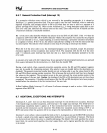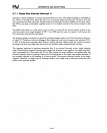
SYSTEM CONTROL
AND
INITIALIZATION
7
07
o
+5
INTEL RESERVED'
I
BASE
23
·'6
+4
+3
BAS~'5.0
+2
+1
LIMIT,5'O
o
15 B 7 o
'MUST
BE
SET
TO
0 FOR
COMPA
TlBIL/TY WITH THE
80386
G30108
Figure 10-3. Data
Type
for
Global
Descriptor
Table and
Interrupt
Descriptor
Table
The task register (TR) points
to
the task state segment for the currently active task.
It
is
similar
to
a
segment register, with selector, base, and limit fields, of which.only the selector field
is
readable under
normal circumstances. Each such selector serves
as
a unique identifier for its task. The
uses
of the
TR
are described
In
Chapter
8.
The instructions controlling these special registers are described in the next section.
10.2
SYSTEM CONTROL INSTRUCTIONS
The instructions that load the GDTR and IDTR from memory can only be executed
in
real address
mode or
at
privilege level
0;
otherwise exception
13
occurs. The store instructions for GDTR and
IDTR
may
be
executed at any privilege level. The four instructions are LIDT, LGDT, SIDT, and SGDT.
The instructions
move
3 words between the indicated descriptor table register and the effective real
memory address supplied (see figure 10-3). The format of the 3
words
is:
a 2-byte limit, a 3-byte real
base address, followed by an unused byte. These instructions are normally used during system
ini tializa tion.
The LLDT instruction loads the LDT registers from a descriptor in the GDT. LLDT
uses
a selector
operand
to
that descriptor rather than referencing the descriptor directly. LLDT
is
only executable
at
privilege level
0;
otherwise exception
13
occurs. LLDT
is
normally required only during system initial-
ization because the processor automatically exchanges the LDTR contents as part of the task-switch
operation.
Executing an LLDT instruction'does not automatically update the
TSS or the register caches. To
properly change the LDT of the currently running task
so
that the change holds across task switches,
you
must perform,
in
order, the following three steps:
1.
Store the
new
LDT selector into the appropriate word of TSS.
2.
Load the
new
LDT selector into LDTR.
3.
Reload the DS and ES registers if they refer to LDT-based descriptors.
Note that the current code segment and stack segment descriptors. should reside in the GDT or be
copied to the same location in the
new
LDT.
10-3


















